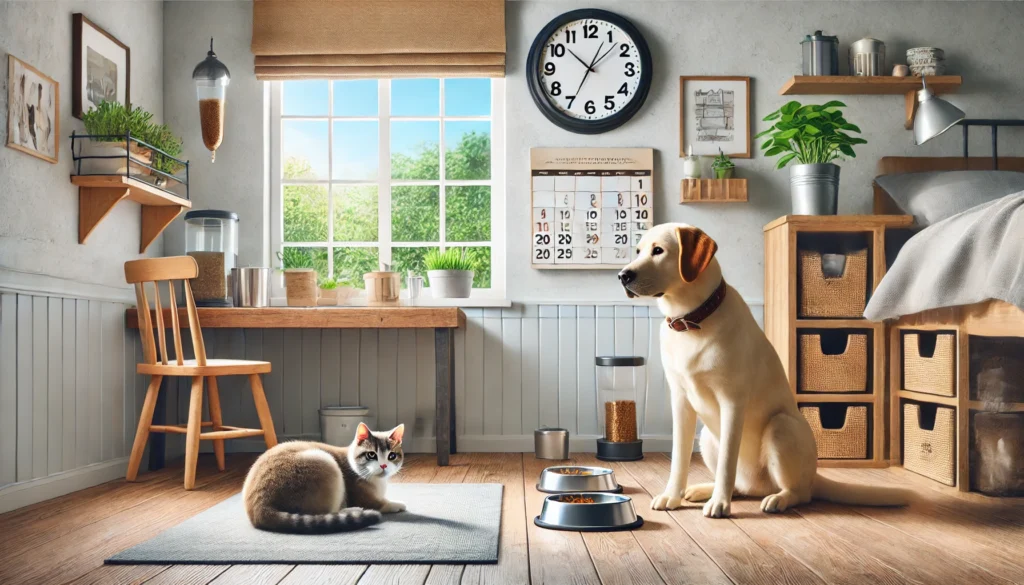Changing your pet’s routine can be stressful — for both of you. Whether you’re starting a new job, moving, welcoming a new family member, or simply adjusting your daily rhythm, cats and dogs feel the impact. These changes may seem small to humans, but to animals, they disrupt a deeply ingrained sense of security.
A thoughtful transition helps your pet adapt calmly and confidently, reducing behavioral issues like barking, pacing, accidents, or excessive meowing. In this article, you’ll learn how to shift your dog’s or cat’s schedule with minimal stress.
Why Routine Matters for Pets
Dogs and cats thrive on predictability. Knowing when they’ll eat, play, go outside, or rest helps them feel in control of their environment.
Disrupting a routine can cause:
- Anxiety or clinginess
- Missed potty breaks
- Loss of appetite
- Litter box accidents
- Sleep issues
- Behavioral regressions (e.g., chewing, vocalizing)
For indoor pets, structure is one of the most important forms of emotional stability.
When Schedule Changes Are Common
Some common reasons for shifting a pet’s routine include:
- Returning to in-office work after remote periods
- Moving to a new home
- A baby, roommate, or new pet joining the household
- Adjusting daylight savings or seasonal shifts
- Pet transitioning from puppy/kitten to adult
- Travel routines, vacations, or boarding care
Preparing your pet in advance prevents confusion and supports a smoother adjustment.
Step-by-Step: How to Transition a Pet’s Schedule
Step 1: Identify the Core Schedule Elements
Before making any changes, define what parts of your pet’s current routine are most important:
- Meal times
- Potty breaks (for dogs) or litter box maintenance (for cats)
- Walks or exercise
- Play sessions
- Alone time vs. together time
- Sleep cues (bedtime, crate time, etc.)
Once you understand the structure, you’ll know what to shift — and what to keep stable.
Step 2: Change One Thing at a Time
Avoid shifting everything at once. Instead, adjust in increments:
- Move meals or walks 15 minutes earlier/later every 2–3 days
- Add alone-time gradually with short sessions
- Introduce new cues (e.g., music, treats, or toys) to mark transitions
A 1-hour routine shift should take about 3–7 days.
Step 3: Use Consistent Cues and Markers
Animals learn through association. Use sensory cues to signal the change:
- Play soft music or use a calming scent at the same time each day
- Offer a “settle” cue with a chew, mat, or toy before leaving
- Say consistent phrases (“Be right back,” “Nap time,” etc.) during transitions
These signals help your pet know what’s coming — even if the timing has changed.
Step 4: Reinforce Calm Behavior During Adjustments
When your pet stays calm at a new mealtime or handles alone time well:
- Offer treats or gentle praise
- Use toys or puzzle feeders to reward waiting
- Add a short play session after they succeed in adapting
Positive reinforcement builds confidence during unfamiliar moments.
Step 5: Maintain Their Core Needs
Even if your own schedule is hectic, protect their non-negotiables:
- Daily exercise (even if it’s shorter)
- Clean litter boxes or potty access
- Quiet time or nap zones
- Daily attention and interaction
When these essentials stay steady, pets are more resilient during change.
Special Tips for Dogs
Dogs are especially sensitive to their owner’s presence and departure.
Help your dog adjust by:
- Practicing “alone time” before you’re gone for long stretches
- Using enrichment (lick mats, frozen toys) to pass the time
- Offering structured walks at the new time consistently
- Crating or using a quiet room as a predictable safe space
If separation anxiety appears, consult a trainer for gradual desensitization techniques.
Special Tips for Cats
Cats notice even subtle changes, like different lighting or furniture placement.
Ease the change for cats by:
- Keeping litter boxes in consistent locations
- Maintaining feeding schedules as closely as possible
- Using calming pheromones (like Feliway) during transitions
- Creating hideouts or high perches where they feel secure
- Introducing new scents or routines slowly (especially in multi-pet homes)
Cats adjust best when change happens on their terms — don’t rush the process.
What to Expect During Adjustment
Even with a gentle transition, your pet may show temporary signs of confusion, such as:
- Waking up earlier than you want
- Barking or whining near meal or walk time
- Pacing or restlessness at night
- Increased attachment or neediness
Stay patient, offer reassurance, and stick to the new schedule. Most pets adapt within 1–2 weeks.
When to Seek Help
If your pet continues to struggle after a few weeks:
- Consult your veterinarian to rule out health concerns
- Work with a certified behaviorist or trainer for anxiety or reactivity
- Consider pet-safe enrichment daycare if they’re overstimulated alone
No pet should suffer due to a schedule shift. Help is available — and early support prevents bigger issues later.
You’re Not Alone in the Adjustment
Changing routines is hard — for both humans and pets. But with empathy, structure, and small steps, you can help your furry companion stay balanced, loved, and secure through every transition life throws your way.
After all, home is about consistency — and you’re the constant they trust the most.






